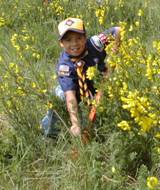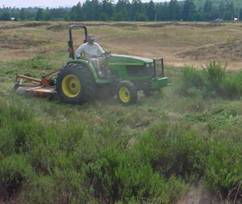The Problem with Scotch Broom Invasion
Scotch broom, (Cytisus scoparius) a non-native woody pest plant, continues to pose a threat to the prairie landscape. It is difficult to destroy, and can take years to eradicate. It is a sturdy plant that after 3 years of age sends out seeds that remain generative for fifty years. A mature invasion of Scotch broom can form a dense monoculture while fixing the soils with nitrogen. By adding this nutrient to the soil above naturally occurring levels, the diversity of native species may be negatively affected, as plants that serve as food and habitat sources began to die out and are replaced by non-native invaders. It has also been suggested that a Scotch broom invasion may actually facilitate the invasion of other aggressive non-native species as well. Efforts to control Scotch broom through hand-pulling of young plants, mowing, managed fires, and the use of some herbicides have been effective. Management and restoration of the prairies must also take the time of year into account. Because these prairies are active habitats for a number of threatened, and in some cases endangered, species, what action is taken, and when is critical.
Click here for full .pdf file
Techniques for Managing Scotch Broom Invasions
 Humans have actively managed prairies and oak woodlands for thousands of years. This management has been a necessary tool to help preserve what is left of the prairie landscape. However, due to the prevalence of non-native species, such as Scotch broom, and the critical loss of prairie habitat, immediate action is needed in order to restore what is left. Humans have actively managed prairies and oak woodlands for thousands of years. This management has been a necessary tool to help preserve what is left of the prairie landscape. However, due to the prevalence of non-native species, such as Scotch broom, and the critical loss of prairie habitat, immediate action is needed in order to restore what is left.
Today, there is a range of possible control techniques that have proven effective for producing high mortality rates of Scotch broom. When planning management strategies it is important to note that the use of multiple techniques based on plant density and maturity can be critical to the programs success. Due to the tenacity of this plant, control of Scotch broom requires a consistent, long-term effort, with each progressive year decreasing the amount of resources needed to produce the desired effect.
 The range of controls include: mechanical controls, prescribed fires, herbicide controls and ultimately restorative practices. These controls vary in effectiveness, costs, and follow-up requirements. The document entitled, “Integrated Control of Scotch Broom: Techniques and Strategies” discusses these control techniques in detail and provides charts for recommended technique matching and on-going yearly management strategies. The range of controls include: mechanical controls, prescribed fires, herbicide controls and ultimately restorative practices. These controls vary in effectiveness, costs, and follow-up requirements. The document entitled, “Integrated Control of Scotch Broom: Techniques and Strategies” discusses these control techniques in detail and provides charts for recommended technique matching and on-going yearly management strategies.
Maintaining consistent and appropriate control efforts is an integral part of successful Scotch broom management programs.
|



